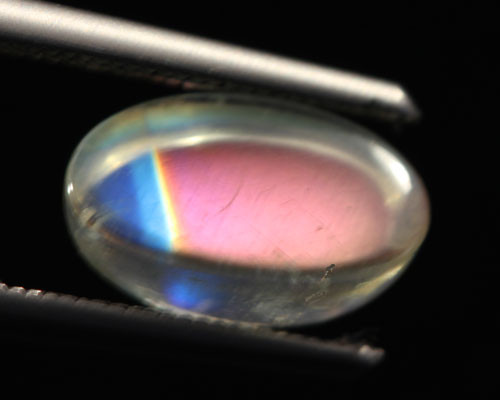Product Overview
Loose Rare Genuine Natural Pink Moonstone Gemstone!
Rare New Find! Magical Pink Rainbow Moonstone from Madagascar! Very RARE to find in Pink color! This gem has a very rare Pink Sheen that appears as it is tilted. This moonstone is so much prettier than the pictures show! The rare color is just amazing! You will also see a golden glow, blue, pink and green colors when this Moonstone is tilted These moonstones have no darkness to them, they are picking up a reflection of the black background in the picture, the white spots are from the lights and not in the gemstone.
Indeed Moonstone owes its name to that mysterious shimmer which always looks different when the stone is moved and is known in the trade as "adularescence." The moonstone is characterized by an enchanting play of light.
This Moonstone was mined in Madagascar.
Great Collector Gemstone. MOHS SCALE 6.0 to 6.5
They say Moonstone fosters happiness, good fortune, nurturing, unselfishness, humanitarian love, hope, spiritual insight, easy childbirth, safe travel on water, new beginnings, abundance and ancient wisdom. This gemstone gets in touch with our feelings and is linked to the moon. Moonstone attunes its energies to the moon's phases. Moonstone is also protective of women and nature, and is a sacred stone of the moon goddess.
This Pink Moonstone is a perfect gem for a unique jewelry piece such as a ring or a pendant!
Origin: Madagascar
Color: silvery-white body color with strong Pink ghost sheen and multi rainbow colors
Carat Weight: 2.07 cts.
Shape/Cut: Custom Rectangle Cabochon
Size: 9.5 X 7.3 MM Depth: 3.7 MM
Clarity: Translucent
Treatment: None, 100% Natural!
Gems and Gemology Fall-2012

are from Madagascar. Photo by Robert Weldon.
Rainbow moonstone is best known from India (see Summer 1997 Gembut material from two relatively new localities was sold at the 2012 Tucson gem shows.
The Madagascar stones were offered by Paul Dragone (Boston Gems, Boston, Massachusetts), who loaned a 4.41 ct sample to GIA for examination. Mr. Dragone first encountered the rough material at the 2011 Tucson gem shows. Initially, from 12 rough pieces weighing about 3 g each, he cut more than a dozen cabochons weighing up to 7.11 ct (18% yield). Later he obtained additional rough material, from which he cut 35 cabochons that averaged approximately
3 ct each.
The gemological properties of the 4.41 ct cushion-shaped double cabochon were: color—near colorless, displaying orange, yellow, green, blue, and violet adularescence; diaphaneity—transparent; spot RI—1.56; hydrostatic SG—2.69; andfluorescence—weak white to long-wave UV radiation, and weak red to short-wave UV. No absorption lines were visible with the desk-model spectroscope. These properties are consistent with those reported for plagioclase (M. O’Donoghue Gems, 6th ed., Butterworth-Heinemann, Oxford, UK, 2006, pp. 259–269), and are also similar to the rainbow moonstone (andesine–labradorite) recently reported from Zambia. Microscopic examination revealed polysynthetic twinning, a typical feature of plagioclase, as well as small “fingerprints” and numerous scattered reflective films. Many of these films were oriented along twinning planes.
EDXRF spectroscopy showed the presence of Al, Si, Ca, and Na (consistent with plagioclase), as well as traces of Fe, Sr, and Ba. Laser ablation–inductively coupled plasma–mass spectrometry (LA-ICP-MS) data further placed it approximately halfway between the plagioclase end members albite and anorthite, on the andesine/labradorite border with a compositional range of Ab48.6–51.7An49.8–46.8Or1.6–1.5.
The rainbow colors were best viewed against the dark background afforded by darkfield illumination (figure 22), but they were also easily seen in transmitted light. In addition, a billowy adularescent effect was produced by a fiber-optic light source positioned over the stone, with orange predominating over other colors, and was best seen when the light was aligned perpendicular to the twin planes. The twin planes, on the other hand, changed from dark to light lines depending on the light orientation.


When the stone was viewed down its length, particularly under magnification with the fiber-optic light held close to the surface, it appeared hazy, consistent with the light scattering that accompanies adularescence.
Traditional moonstone (orthoclase) displays a white to blue adularescence thought to be caused by Rayleigh scattering
of light from the exsolution of albite within the Kfeldspar structure (E. Fritsch and G. R. Rossman, “An update on color in gems, part 3: Colors caused by band gaps and physical phenomena,” Summer 1988 G&G, pp. 81–102).
Labradorescence is an interference phenomenon that may be exhibited by labradorite due to the diffraction of light from exsolution lamellae of varying Ca content, potentially producing many spectral colors; the relative thicknesses and differing refractive indices of the lamellae determine which colors are visible (Fritsch and Rossman,1988). The present moonstone (andesine-labradorite) exhibits a rainbow-colored effect that results from a combination of labradorescence and adularescence.
Claire Ito (cito@gia.edu)
GIA, New York








